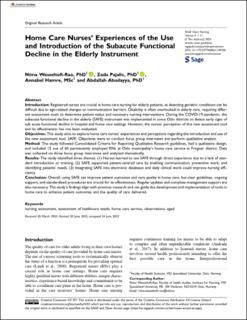| dc.contributor.author | Wesseltoft-Rao, Nima | |
| dc.contributor.author | Pajalic, Zada | |
| dc.contributor.author | Hamre, Annabel | |
| dc.contributor.author | Abudayya, Abdallah | |
| dc.date.accessioned | 2023-08-17T13:19:33Z | |
| dc.date.available | 2023-08-17T13:19:33Z | |
| dc.date.created | 2023-08-14T10:11:01Z | |
| dc.date.issued | 2023 | |
| dc.identifier.citation | Nursing Open. 2023, 9,1-11 | en_US |
| dc.identifier.issn | 2054-1058 | |
| dc.identifier.uri | https://hdl.handle.net/11250/3084630 | |
| dc.description.abstract | Introduction: Registered nurses are crucial in home care nursing for elderly patients, as detecting geriatric conditions can be difficult due to age-related changes or communication barriers. Disability is often overlooked in elderly care, requiring different assessment tools to determine patient status and necessary nursing interventions. During the COVID-19 pandemic, the subacute functional decline in the elderly (SAFE) instrument was implemented in some Oslo districts to detect early signs of sub acute functional decline in hospital and home care settings. However, the nurses’ perception of this new assessment tool and its effectiveness has not been evaluated.
Objectives: This study aims to explore home care nurses’ experiences and perceptions regarding the introduction and use of the new assessment tool, SAFE. Objectives were to conduct focus group interviews and perform qualitative analysis.
Method: The study followed Consolidated Criteria for Reporting Qualitative Research guidelines, had a qualitative design, and included 15 out of 60 permanently employed RNs at Oslo municipality's home care service in Frogner district. Data was collected via three focus group interviews and analyzed thematically.
Results: The study identified three themes: (1) Nurses learned to use SAFE through direct experience due to a lack of standard introduction or training. (2) SAFE supported patient-centred care by enabling communication, preventive work, and identifying patients’ needs. (3) Integrating SAFE into electronic databases and daily clinical work could improve nursing efficiency.
Conclusion: Overall, using SAFE can improve patient outcomes and care quality in home care, but clear guidelines, ongoing support, and standardized procedures are crucial for its effectiveness. Regular updates and complete management support are also necessary. The study's findings align with previous research and can guide the development and implementation of tools in home care to enhance patient outcomes and the quality of care delivered. | en_US |
| dc.language.iso | eng | en_US |
| dc.publisher | Sage Journals | en_US |
| dc.rights | Navngivelse 4.0 Internasjonal | * |
| dc.rights.uri | http://creativecommons.org/licenses/by/4.0/deed.no | * |
| dc.subject | aged | en_US |
| dc.subject | observations | en_US |
| dc.subject | home care service | en_US |
| dc.subject | assessment of healthcare needs | en_US |
| dc.subject | nursing assessment | en_US |
| dc.title | Home care nurses’ experiences of the use and introduction of the subacute functional decline in the elderly instrument | en_US |
| dc.type | Peer reviewed | en_US |
| dc.type | Journal article | en_US |
| dc.description.version | publishedVersion | en_US |
| dc.rights.holder | © The Author(s) 2023, Article Reuse Guidelines | en_US |
| dc.source.pagenumber | 1-11 | en_US |
| dc.source.volume | 9 | en_US |
| dc.source.journal | Nursing Open | en_US |
| dc.identifier.doi | 10.1177/23779608231187246 | |
| dc.identifier.cristin | 2166649 | |
| cristin.ispublished | true | |
| cristin.fulltext | original | |
| cristin.qualitycode | 1 | |

